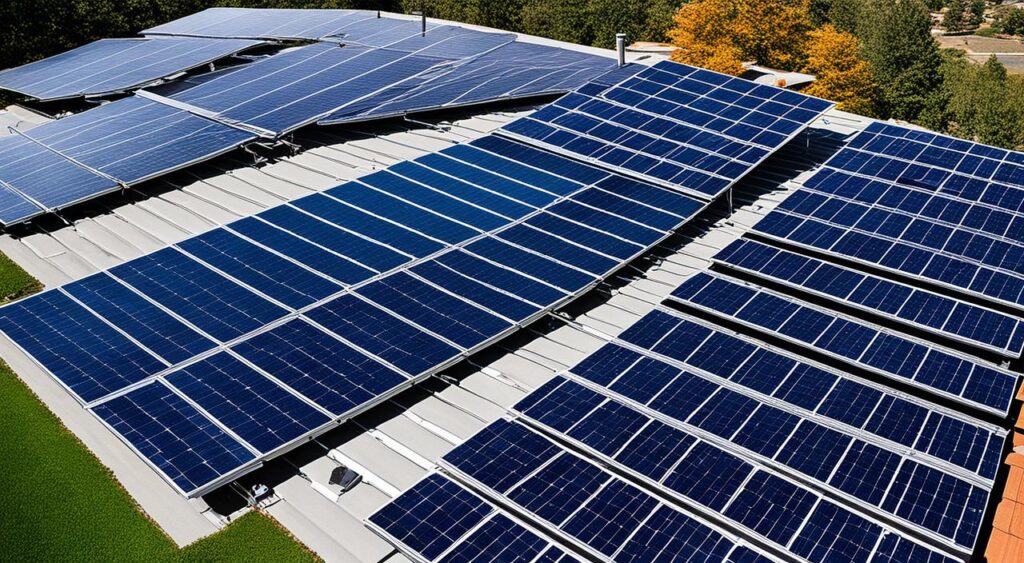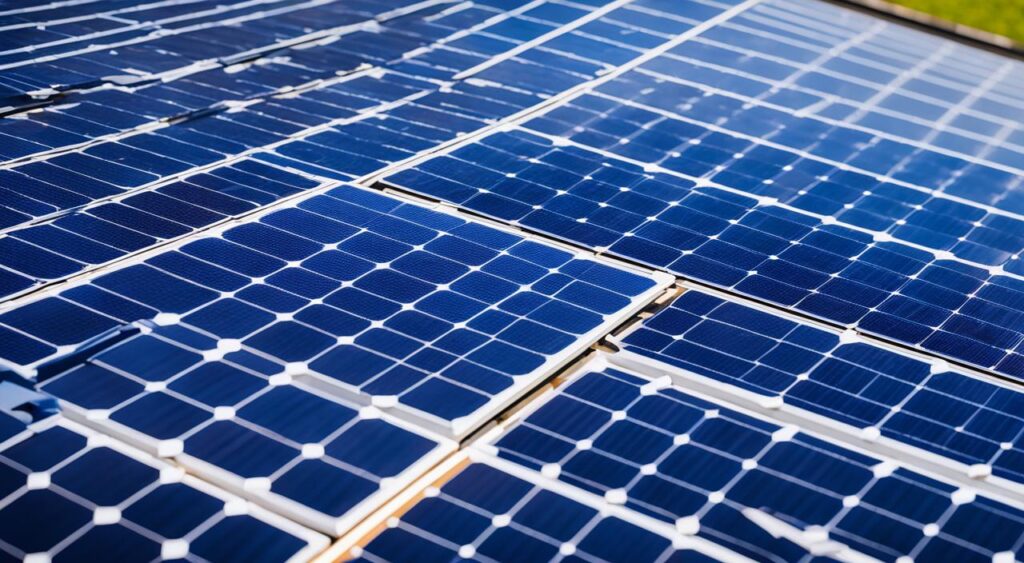Tier 1 vs Tier 2 Solar Panels: Pros and Cons
In the fast-growing solar energy field, knowing the difference between Tier 1 and Tier 2 solar panels is key. This knowledge helps homeowners, businesses, and solar experts make better choices for their projects. We’ll look into the good and bad of each type to guide you in picking the right one for you.
Key Takeaways
- Tier 1 solar panels are usually more efficient and reliable, with longer warranties, but they cost more at first.
- Tier 2 solar panels are more affordable but might not work as well and have shorter warranties.
- When picking between Tier 1 and Tier 2, think about how much energy they make, how long they last, and their cost.
- Industry standards and certifications are key to making sure solar panels work well and last long.
- Your choice between Tier 1 and Tier 2 solar panels depends on what you need for your solar project, whether it’s for your home or business.
Understanding Solar Panel Tiers
Solar panels are sorted into tiers based on certain criteria. This is key when picking panels for your home or business solar project.
What are Tier 1 and Tier 2 Solar Panels?
Tier 1 solar panels are top-notch, made by stable and reliable companies. They’re known for great performance, lasting long, and being very reliable. Tier 2 panels come from smaller or newer companies. They might not match Tier 1’s quality or stability.
The Importance of Solar Panel Classification
Classifying solar panels helps buyers and installers make smart choices. It tells them about the panels’ quality, warranty, and how well they’ll perform over time. Knowing the differences between Tier 1 and Tier 2 helps you pick the best for your needs and budget.
| Tier 1 Solar Panels | Tier 2 Solar Panels |
|---|---|
| Produced by financially stable and reliable manufacturers | Manufactured by smaller or less established companies |
| Known for exceptional performance, durability, and long-term reliability | May not have the same level of quality assurance and financial stability |
| Considered the highest quality solar panels | May not offer the same level of warranty coverage and long-term performance |

“Understanding the differences between Tier 1 and Tier 2 solar panels is crucial for making informed decisions about your solar energy investment.”
Efficiency: A Key Differentiator
Efficiency is key when comparing solar panel performance. Tier 1 panels use advanced tech to turn more sun energy into electricity. This makes them better than Tier 2 panels in solar panel efficiency and solar energy production.
This means Tier 1 panels can make more power from the same sunlight. This leads to more energy and savings over time.
“Tier 1 solar panels are designed to maximize the conversion of solar energy into electricity, offering homeowners and businesses a more efficient and cost-effective solution for their renewable energy needs.”
Tier 2 panels, on the other hand, convert less sunlight into electricity. This means they produce less power and might cost more to use. Choosing the right panels is important for saving money and getting a good return on investment (ROI).

In short, efficiency is what makes Tier 1 panels stand out. Knowing how Tier 1 panels work better can help people and businesses pick the best options for their energy needs and budgets.
Pros and Cons of Tier 1 vs. Tier 2 Solar Panels
Choosing between Tier 1 and Tier 2 solar panels is crucial. Each type has its own benefits and drawbacks. It’s important to look at these carefully before making a decision.
Tier 1 Solar Panel Advantages
Tier 1 solar panels are known for their top-notch quality and reliability. They have higher efficiency ratings, turning more sunlight into electricity. Plus, Tier 1 brands offer strong warranties, giving you peace of mind for years to come.
Tier 2 Solar Panel Advantages
Tier 2 solar panels are a budget-friendly choice. They still provide reliable power and are a smart pick for those watching their spending. These panels help you save money without sacrificing too much performance.
| Tier 1 Solar Panels | Tier 2 Solar Panels |
|---|---|
| Higher efficiency ratings | More affordable upfront cost |
| Comprehensive warranties | Slightly lower reliability ratings |
| Superior quality and reliability | Potential for slightly lower performance |
Choosing between Tier 1 and Tier 2 solar panels depends on your needs and budget. Think about your energy goals and the pros and cons of each type. This way, you can pick the best option for your solar setup.
“The quality of the solar panels you choose can have a significant impact on the long-term performance and return on your solar investment.”
Lifespan and Warranty Considerations
When looking at solar panel investments, think about their lifespan and warranty. Tier 1 solar panels are built to last, with warranties up to 25 to 30 years. This means they can keep producing energy for decades, giving you peace of mind.
Tier 2 solar panels also offer good performance for many years, but with shorter warranties. It’s important to look at the warranty and lifespan to choose the best for your needs.
Tier 1 Solar Panel Warranties
Tier 1 solar panels come with great warranties. These include:
- 25-30 years of coverage for the panel’s power output, ensuring consistent energy generation over the long term.
- Comprehensive protection against manufacturing defects or premature degradation, giving you peace of mind about your investment.
- Guarantees of 90-95% of the panel’s initial power output even after decades of use, showing their durability and reliability.
Tier 2 Solar Panel Warranties
Tier 2 solar panels don’t have the same long warranties as Tier 1, but they’re still reliable for years. Their warranties usually include:
- Warranty periods ranging from 20-25 years for power output guarantees.
- Protections against manufacturing defects that could affect the panel’s performance.
- Assurances of 80-90% of the panel’s initial power output after years of use, showing their long-term reliability.
When choosing between Tier 1 and Tier 2 solar panels, think about their warranties and lifespan. This will help you make a choice that fits your energy needs and budget.
Cost Implications: Initial Investment vs Long-Term Savings
The cost of solar panel installation is a big factor to think about. Tier 1 solar panels are pricier upfront but are more efficient and reliable. This means they save money over time by producing more energy and needing less upkeep. Tier 2 panels are cheaper at first but might not work as well or last as long. It’s important to weigh these differences to get the best deal for your solar project.
Let’s dive into the costs of Tier 1 and Tier 2 solar panels:
| Metric | Tier 1 Solar Panels | Tier 2 Solar Panels |
|---|---|---|
| Initial Cost of Solar Panels | Higher | Lower |
| Solar Energy Savings | Higher | Lower |
| Solar Panel Installation Costs | May be slightly higher | May be slightly lower |
| Long-Term Maintenance Costs | Lower | Higher |
The upfront cost of solar panels is important, but don’t forget to look at the long-term solar energy savings and solar panel installation costs. Tier 1 panels cost more at first but save more money over time. This makes them a better value for your money.
“The true cost of solar energy goes beyond the initial investment. Considering the long-term savings and the overall system performance is key to finding the best value for your solar project.”
Solar Panel Reliability and Performance
Solar energy relies on the reliability and performance of solar panels. Tier 1 panels are known for their durability and consistent power output. They also have minimal degradation over time. Tier 2 panels might be cheaper but may not match Tier 1’s reliability and performance.
Tier 1 Solar Panel Reliability
Tier 1 solar panels are built to last. They go through strict quality checks. This makes them efficient and durable, even in tough conditions. These panels lose less than 0.5% power each year, ensuring steady solar energy for many years.
Tier 2 Solar Panel Reliability
Tier 2 panels are more budget-friendly but might not be as reliable as Tier 1. They could face more performance problems, like faster power loss or damage from the environment. Yet, not all Tier 2 panels are the same. Some can still be reliable and perform well.
| Metric | Tier 1 Solar Panels | Tier 2 Solar Panels |
|---|---|---|
| Degradation Rate | Less than 0.5% annually | Varies, potentially higher |
| Durability | Highly durable, designed to withstand elements | May be more susceptible to environmental damage |
| Warranty | Typically 25-30 years | Typically 20-25 years |
Choosing the right solar panels means looking at the manufacturer’s track record and quality control. Knowing the differences between Tier 1 and Tier 2 panels helps you make a smart choice. This way, you can meet your solar energy goals.
Residential vs Commercial Solar Installations
Choosing between Tier 1 and Tier 2 solar panels depends on the application. Homeowners and commercial projects have different needs. These needs affect their choice of solar panels.
For homes, looks, warranty, and reliability matter most. Homeowners want their solar panels to look good and last long. They like Tier 1 panels for their good looks and solid warranties.
Commercial projects look at energy production and profit. They choose Tier 1 panels for their high efficiency. This means they can make more electricity and earn more money. The durability of Tier 1 panels is also key for big projects, as it helps avoid costly downtime.
| Residential Solar Installations | Commercial Solar Projects |
|---|---|
| Aesthetics, warranty, reliability | Energy production, ROI |
| Tier 1 or Tier 2 based on homeowner preferences | Tier 1 panels for higher efficiency and performance |
Knowing what residential and commercial solar setups need helps pick the right solar panel tier. This ensures the chosen panels meet the project’s goals and needs.
Industry Standards and Certifications
In the solar industry, high-quality standards are key. To make sure solar panels work well and last long, many groups have set strict rules and certifications. These certifications prove the panels meet quality and safety levels.
The IEC (International Electrotechnical Commission) certification is a top standard for solar panels. It checks how tough, safe, and electrically sound the modules are. The UL (Underwriters Laboratories) certification is also big, checking if solar products are safe and reliable.
The ENERGY STAR® label is another big deal. It means the solar panels are energy-efficient and meet the EPA’s standards. This is great for those wanting to save energy and cut down on carbon emissions.
| Certification | Criteria | Relevance |
|---|---|---|
| IEC | Durability, safety, and electrical performance | Internationally recognized standard for solar panels |
| UL | Safety and reliability | Widely respected certification in the solar industry |
| ENERGY STAR® | Energy efficiency and performance | Valuable for maximizing energy savings and reducing carbon footprint |
Tier 1 solar panels must meet strict standards, ensuring top solar module quality assurance. Tier 2 panels might not always match these standards, which could affect their reliability and performance over time. When picking solar panels, it’s important to check the solar industry standards and certifications. This way, you get a system that’s durable and works well, giving you the best value for your money.
Conclusion
We’ve looked into the differences between Tier 1 and Tier 2 solar panels. We found that Tier 1 panels are usually more efficient and last longer. They also come with better warranties. But, Tier 2 panels can be a cheaper choice for some solar projects.
Choosing between these tiers depends on what you need, how much you can spend, and your goals for solar energy. Think about the good and bad of each option. This way, you can pick the best choice for your needs and get the most from your tier 1 vs. tier 2 solar panels and solar energy investment.
Choosing the right type of solar panel is key to getting sustainable and affordable energy. By knowing the details of solar panel selection, you can make a smart choice. This choice will help you succeed in your solar energy investment for a long time.

